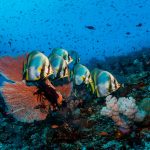Navigating the Currents: Diving Seasons in Komodo National Park
Komodo National Park, located in the heart of the Indonesian archipelago, is renowned for its stunning underwater landscapes, diverse marine life, and thrilling diving experiences. However, understanding the seasonal variations in sea currents is essential for planning a safe and enjoyable diving trip. In this article, we explore the current situation for diving in Komodo National Park, including the best seasons for beginners to learn diving and for advanced divers to embark on more challenging underwater adventures.
Understanding Sea Currents in Komodo
Komodo National Park is characterized by a complex system of currents influenced by the monsoon seasons. During the dry season, from April to November, strong southeast trade winds generate upwellings and currents that flow through the park’s channels and straits. These currents can range from gentle to strong, creating thrilling drift dives and attracting pelagic species such as mantas and sharks. Conversely, during the rainy season, from December to March, the winds shift to the northwest, resulting in calmer seas and less predictable currents.
Best Season for Beginner Divers
For beginner divers seeking calm seas and optimal learning conditions, the dry season from April to November is the ideal time to visit Komodo National Park. During this period, the strong southeast trade winds typically result in clear visibility and gentle to moderate currents, making it easier for novice divers to navigate underwater environments. Additionally, dive sites with sheltered conditions, such as shallow reefs and calm bays, provide ideal learning environments for beginner divers to gain confidence and skills under the guidance of certified instructors.
Best Season for Advanced Divers
Advanced divers looking for exhilarating underwater experiences and encounters with pelagic species may prefer the dry season, particularly from July to September. During this period, the currents are stronger and more predictable, creating ideal conditions for drift dives and thrilling underwater adventures. Dive sites such as Batu Bolong, Castle Rock, and Manta Point are renowned for their challenging conditions and opportunities to encounter reef sharks, mantas, and other large marine predators. However, advanced divers should be well-prepared and possess the necessary skills and experience to handle strong currents and navigate complex underwater terrain safely.
Safety Tips for Diving in Komodo
Regardless of the season, safety should always be the top priority when diving in Komodo National Park. Before embarking on any dive, divers should:
1. Check Weather and Tide Conditions: Stay informed about weather forecasts, tide tables, and current conditions to ensure safe diving conditions.
2. Dive with Certified Instructors: Beginners should undergo training with certified dive instructors and follow proper diving procedures at all times.
3. Use Dive Computers: Utilize dive computers to monitor depth, bottom time, and decompression limits, and adhere to safe diving practices.
4. Stay Close to the Group: Always dive with a buddy and stay close to the dive group to ensure mutual support and assistance if needed.
5. Respect Marine Life: Practice responsible diving behaviors, avoid touching or disturbing marine life, and follow established marine conservation guidelines.
In conclusion, understanding the seasonal variations in sea currents is crucial for planning a safe and enjoyable diving experience in Komodo National Park. While the dry season offers optimal conditions for beginner divers to learn and explore, the stronger currents during this period provide advanced divers with thrilling opportunities for underwater adventures. By adhering to safety protocols, diving with certified instructors, and respecting the marine environment, divers can make the most of their diving experiences while exploring the breathtaking underwater world of Komodo National Park.


